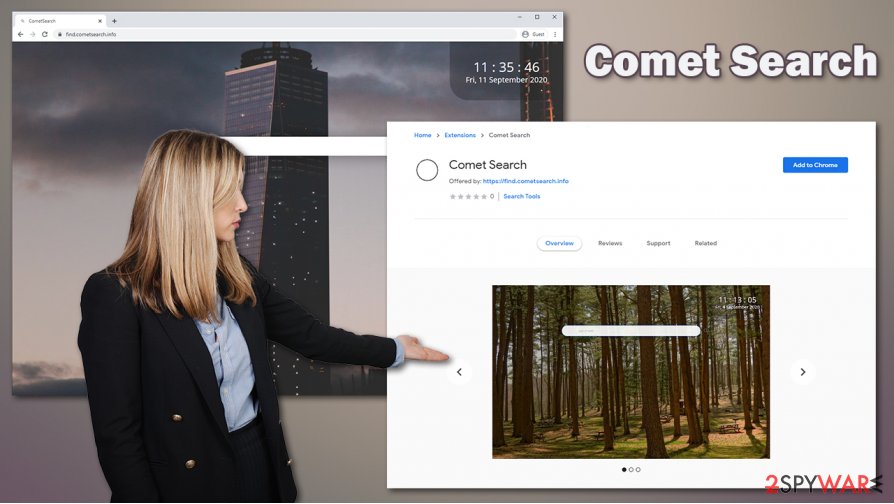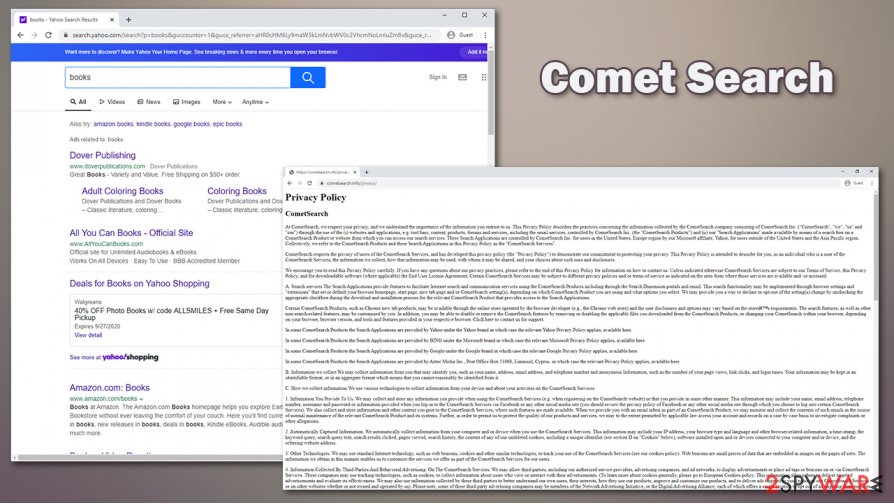Comet Search (Easy Removal Guide) - Free Instructions
Comet Search Removal Guide
What is Comet Search?
Comet Search is a browser hijacker that inserts ads into your searches

Comet Search is a potentially unwanted program that is typically distributed via software bundle packages, which results in unintentional installation. Once inside, the app modified web browser settings of Google Chrome, Mozilla Firefox, Safari, or MS Edge in a way that would allow it to perform its deceptive activities. For example, the PUP sets find.cometsearch.info as the homepage and new tab address of the web browser and appends a customized search engine to it.
As a result, users who browse via the Comet Search hijack affected browser would quickly notice that all their searches are redirected to Yahoo. While this might seem like not a big deal, most would not be satisfied that their default search engine has changed. By far, the bigger issue is that the browser hijacker injects sponsored links and ads into search results and spies on users with the help of data-tracking technologies.[1]
| Name | Comet Search |
| Type | Browser hijacker |
| Distribution | The extension can be downloaded from official sources, although most users install it through software bundle packages downloaded from third-party sites, as well as deceptive advertisements encountered online |
| Symptoms | An unknown browser extension installed on the web browser; all search results redirected to Yahoo or another engine; sponsored links and ads shown at the top of the results; overall increased amount of advertisements |
| Associated risks | Installation of other unwanted programs/malware, information disclosure to unknown parties (privacy risks), financial loss |
| Elimination | To get rid of the browser hijacker, you should access the settings of your web browser and delete the extension; in case browser changes do not disappear, you might want to search for unwanted programs installed on your system – do it manually as per instructions below or scan the machine with anti-malware such as SpyHunter 5Combo Cleaner or Malwarebytes |
| Further steps | If you found additional unwanted programs or malware installed on your system, you should also reset your web browsers and then attempt to fix virus damage with FortectIntego |
Potentially unwanted programs such as browser hijackers can be encountered in various places, although the most common trait that unites them is that they are mostly installed without asking users for direct permission. This happens due to deceptive techniques that the developers of such apps use, and Comet Search is not an exception – software bundles, deceptive ads, suspicious websites, and other methods can be used.
Browser hijackers are generally not perceived as a high security threat. Indeed, the main goal of Comet Search is to change web browser settings and use the built-in resources to deliver sponsored links in search results. By clicking on these links, users provide financial benefits for the developer. Unfortunately, there is so much more to it.
First of all, CometSearch would redirect all searches to Yahoo – a renowned search engine that is legitimately used by millions of people worldwide. Despite this, the tech giant has nothing to do with the hijacker, and the search results that are filtered through the hijacker are not genuine, so users might struggle to find relevant information.
These ads are not random, however, as Comet Search tracks’ user online behavior with the help of cookies and other technologies:
We may use standard Internet technology, such as web beacons, cookies and other similar technologies, to track your use of the CometSearch Services (see our cookies policy). Web beacons are small pieces of data that are embedded in images on the pages of sites.
The collected data includes the following:
- Provided personal data (name, email, phone number, username and password, etc.);
- Browser-related information (type, language settings);
- Software installed on the device and all the connected devices;
- IP address
- Search information (links clicked, keywords, time stamp, pages viewed, search history, etc.).
Another potentially malicious trait of this browser hijacker is that it might set the “Managed by your organization” setting on the web browser, which might significantly reduce the chance of a successful Comet Search removal. In other words, the PUP abuses built-in settings in order to keep the app installed on the system for as long as possible – a trait that is common to malware and prompts the “Comet Search virus” description from many.

This is why PUPs should not be treated lightly – some of them can cause major browsing inconveniences, reduce the security of the computer, and prevent users from eliminating them. For that reason, security experts[2] highly advise users to remove Comet Search from their browsers as soon as possible. If you are unable to do so, you should reset the web browsers as explained below, look for other suspicious programs and then scan the machine with security and optimization software – we recommend using FortectIntego, SpyHunter 5Combo Cleaner, and Malwarebytes.
Ways browser hijackers sneak into computers and methods of prevention
As previously mentioned, potentially unwanted programs such as browser hijackers typically show up on users’ machines seemingly out of nowhere. If that happened to you, you should check what applications from third-party websites you have recently installed on your computer, as PUPs are mostly distributed via software bundle packages.
Freeware websites are extremely popular, as users are keen to download applications that they believe are free. However, most of such apps (unless they are open-source) use various alternative methods for monetization; these include advertisements, pay-per-install schemes, and others. As a result, each user who installs such programs becomes a monetization vector, and many apps attempt to abuse that fact.
While showing advertisements is a legitimate way to monetize, potentially unwanted programs use various deceptive claims to make users believe that the program is useful, promising “enhanced searches” or “discounts and coupons.” In reality, users are fed with ads and get no value out of the installed programs of such type.
To avoid browser hijackers, adware, scareware,[3] and other potentially unwanted software, you should follow these tips:
- If possible, download apps from official sources and avoid third party sites;
- During the installation, always pick Advanced mode instead of Recommended one to stay in control of the process;
- Decline all the deals and offers;
- Remove ticks from checkboxes (unless it is ToS agreement);
- Read the fine print;
- Install powerful security software that would warn you about PUPs.

Uninstall CometSearch and check for other unwanted apps and malware
Typically, users can uninstall browser extensions easily – all they have to do is access the settings of their web browsers. CometSearch removal would not be a difficult process as well if the browser hijacker would not use persistence mechanisms, which render the browser immune to user inputs. Luckily, there are several ways how to bypass this.
To remove CometSearch successfully, you should first do the following:
- Navigate to C:\Users\username\AppData\Local\Google\Chrome and delete everything
- Reset Google Chrome (or another) web browser as explained below.
Finally, you should also check your computer for other potentially unwanted programs and malware by scanning it with powerful anti-malware software. You can also look for unwanted apps manually – you can find detailed instructions below.
You may remove virus damage with a help of FortectIntego. SpyHunter 5Combo Cleaner and Malwarebytes are recommended to detect potentially unwanted programs and viruses with all their files and registry entries that are related to them.
Getting rid of Comet Search. Follow these steps
Uninstall from Windows
To uninstall apps from Windows machines, follow these steps:
Instructions for Windows 10/8 machines:
- Enter Control Panel into Windows search box and hit Enter or click on the search result.
- Under Programs, select Uninstall a program.

- From the list, find the entry of the suspicious program.
- Right-click on the application and select Uninstall.
- If User Account Control shows up, click Yes.
- Wait till uninstallation process is complete and click OK.

If you are Windows 7/XP user, proceed with the following instructions:
- Click on Windows Start > Control Panel located on the right pane (if you are Windows XP user, click on Add/Remove Programs).
- In Control Panel, select Programs > Uninstall a program.

- Pick the unwanted application by clicking on it once.
- At the top, click Uninstall/Change.
- In the confirmation prompt, pick Yes.
- Click OK once the removal process is finished.
Delete from macOS
Remove items from Applications folder:
- From the menu bar, select Go > Applications.
- In the Applications folder, look for all related entries.
- Click on the app and drag it to Trash (or right-click and pick Move to Trash)

To fully remove an unwanted app, you need to access Application Support, LaunchAgents, and LaunchDaemons folders and delete relevant files:
- Select Go > Go to Folder.
- Enter /Library/Application Support and click Go or press Enter.
- In the Application Support folder, look for any dubious entries and then delete them.
- Now enter /Library/LaunchAgents and /Library/LaunchDaemons folders the same way and terminate all the related .plist files.

Remove from Microsoft Edge
Delete unwanted extensions from MS Edge:
- Select Menu (three horizontal dots at the top-right of the browser window) and pick Extensions.
- From the list, pick the extension and click on the Gear icon.
- Click on Uninstall at the bottom.

Clear cookies and other browser data:
- Click on the Menu (three horizontal dots at the top-right of the browser window) and select Privacy & security.
- Under Clear browsing data, pick Choose what to clear.
- Select everything (apart from passwords, although you might want to include Media licenses as well, if applicable) and click on Clear.

Restore new tab and homepage settings:
- Click the menu icon and choose Settings.
- Then find On startup section.
- Click Disable if you found any suspicious domain.
Reset MS Edge if the above steps did not work:
- Press on Ctrl + Shift + Esc to open Task Manager.
- Click on More details arrow at the bottom of the window.
- Select Details tab.
- Now scroll down and locate every entry with Microsoft Edge name in it. Right-click on each of them and select End Task to stop MS Edge from running.

If this solution failed to help you, you need to use an advanced Edge reset method. Note that you need to backup your data before proceeding.
- Find the following folder on your computer: C:\\Users\\%username%\\AppData\\Local\\Packages\\Microsoft.MicrosoftEdge_8wekyb3d8bbwe.
- Press Ctrl + A on your keyboard to select all folders.
- Right-click on them and pick Delete

- Now right-click on the Start button and pick Windows PowerShell (Admin).
- When the new window opens, copy and paste the following command, and then press Enter:
Get-AppXPackage -AllUsers -Name Microsoft.MicrosoftEdge | Foreach {Add-AppxPackage -DisableDevelopmentMode -Register “$($_.InstallLocation)\\AppXManifest.xml” -Verbose

Instructions for Chromium-based Edge
Delete extensions from MS Edge (Chromium):
- Open Edge and click select Settings > Extensions.
- Delete unwanted extensions by clicking Remove.

Clear cache and site data:
- Click on Menu and go to Settings.
- Select Privacy, search and services.
- Under Clear browsing data, pick Choose what to clear.
- Under Time range, pick All time.
- Select Clear now.

Reset Chromium-based MS Edge:
- Click on Menu and select Settings.
- On the left side, pick Reset settings.
- Select Restore settings to their default values.
- Confirm with Reset.

Remove from Mozilla Firefox (FF)
Reset Mozilla Firefox if you are unable to terminate CometSearch virus in a regular way:
Remove dangerous extensions:
- Open Mozilla Firefox browser and click on the Menu (three horizontal lines at the top-right of the window).
- Select Add-ons.
- In here, select unwanted plugin and click Remove.

Reset the homepage:
- Click three horizontal lines at the top right corner to open the menu.
- Choose Options.
- Under Home options, enter your preferred site that will open every time you newly open the Mozilla Firefox.
Clear cookies and site data:
- Click Menu and pick Settings.
- Go to Privacy & Security section.
- Scroll down to locate Cookies and Site Data.
- Click on Clear Data…
- Select Cookies and Site Data, as well as Cached Web Content and press Clear.

Reset Mozilla Firefox
If clearing the browser as explained above did not help, reset Mozilla Firefox:
- Open Mozilla Firefox browser and click the Menu.
- Go to Help and then choose Troubleshooting Information.

- Under Give Firefox a tune up section, click on Refresh Firefox…
- Once the pop-up shows up, confirm the action by pressing on Refresh Firefox.

Remove from Google Chrome
Delete malicious extensions from Google Chrome:
- Open Google Chrome, click on the Menu (three vertical dots at the top-right corner) and select More tools > Extensions.
- In the newly opened window, you will see all the installed extensions. Uninstall all the suspicious plugins that might be related to the unwanted program by clicking Remove.

Clear cache and web data from Chrome:
- Click on Menu and pick Settings.
- Under Privacy and security, select Clear browsing data.
- Select Browsing history, Cookies and other site data, as well as Cached images and files.
- Click Clear data.

Change your homepage:
- Click menu and choose Settings.
- Look for a suspicious site in the On startup section.
- Click on Open a specific or set of pages and click on three dots to find the Remove option.
Reset Google Chrome:
If the previous methods did not help you, reset Google Chrome to eliminate all the unwanted components:
- Click on Menu and select Settings.
- In the Settings, scroll down and click Advanced.
- Scroll down and locate Reset and clean up section.
- Now click Restore settings to their original defaults.
- Confirm with Reset settings.

Delete from Safari
Remove unwanted extensions from Safari:
- Click Safari > Preferences…
- In the new window, pick Extensions.
- Select the unwanted extension and select Uninstall.

Clear cookies and other website data from Safari:
- Click Safari > Clear History…
- From the drop-down menu under Clear, pick all history.
- Confirm with Clear History.

Reset Safari if the above-mentioned steps did not help you:
- Click Safari > Preferences…
- Go to Advanced tab.
- Tick the Show Develop menu in menu bar.
- From the menu bar, click Develop, and then select Empty Caches.

After uninstalling this potentially unwanted program (PUP) and fixing each of your web browsers, we recommend you to scan your PC system with a reputable anti-spyware. This will help you to get rid of Comet Search registry traces and will also identify related parasites or possible malware infections on your computer. For that you can use our top-rated malware remover: FortectIntego, SpyHunter 5Combo Cleaner or Malwarebytes.
How to prevent from getting browser hijacker
Stream videos without limitations, no matter where you are
There are multiple parties that could find out almost anything about you by checking your online activity. While this is highly unlikely, advertisers and tech companies are constantly tracking you online. The first step to privacy should be a secure browser that focuses on tracker reduction to a minimum.
Even if you employ a secure browser, you will not be able to access websites that are restricted due to local government laws or other reasons. In other words, you may not be able to stream Disney+ or US-based Netflix in some countries. To bypass these restrictions, you can employ a powerful Private Internet Access VPN, which provides dedicated servers for torrenting and streaming, not slowing you down in the process.
Data backups are important – recover your lost files
Ransomware is one of the biggest threats to personal data. Once it is executed on a machine, it launches a sophisticated encryption algorithm that locks all your files, although it does not destroy them. The most common misconception is that anti-malware software can return files to their previous states. This is not true, however, and data remains locked after the malicious payload is deleted.
While regular data backups are the only secure method to recover your files after a ransomware attack, tools such as Data Recovery Pro can also be effective and restore at least some of your lost data.
- ^ Chris Hoffman. The Many Ways Websites Track You Online. How-To Geek. Site that explains technology.
- ^ Bedynet. Bedynet. Cybersecurity advice and malware insights.
- ^ What is Scareware?. Forcepoint. Security research blog.























